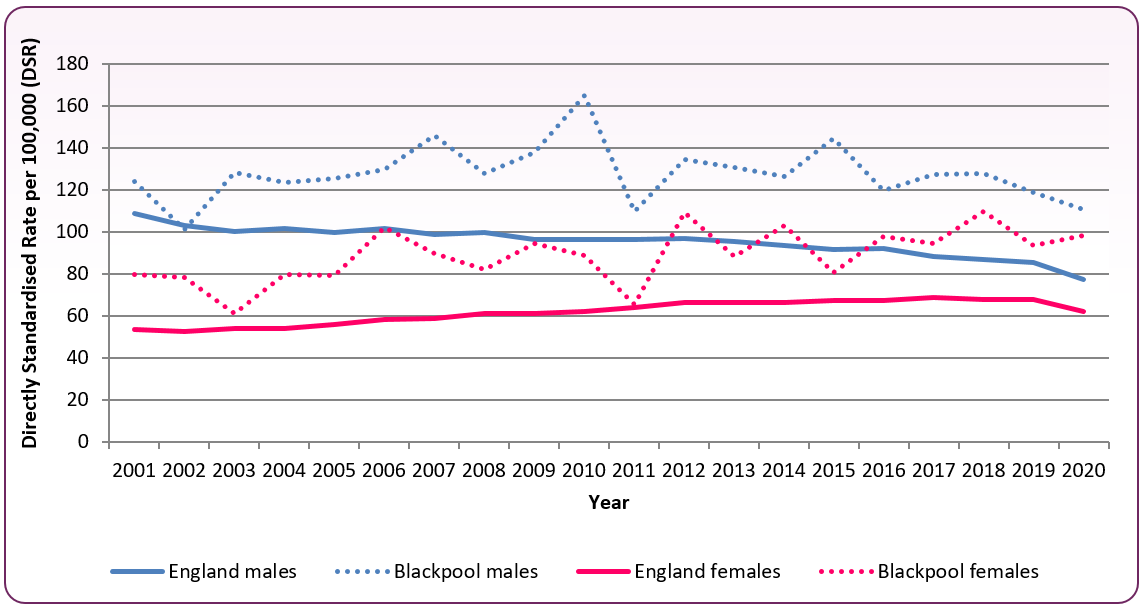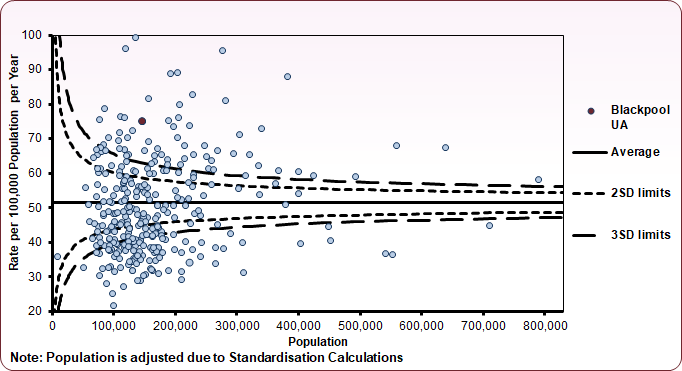Lung Cancer
Last Modified 30/11/2023 13:47:34
Share this page
Introduction
Cancer Research UK provides a brief guide to lung cancer that includes information about symptoms, early detection and possible risk factors.
Facts and figures
Incidence of lung cancer
Incidence is defined as the number of new cases identified in a given period of time.
In Blackpool each year there are approximately 150 new cases of lung cancer identified. Figure 1 shows the trend in the cancer incidence rate in Blackpool and England. The incidence rate (in this case per 100,000 population) is calculated to allow comparison between geographies of different population sizes and with different gender and age make ups.
Nationally lung cancer incidence has fallen consistently in males over many years, but has risen over the same period in females. Lung cancer incidence in Blackpool has remained consistently higher than seen nationally. Lung cancer is primarily caused by smoking and these changing incidence patterns are a reflection of changing historic smoking habits.
Figure 1 - incidence of lung cancer - 2001-2020 annual trend
 Source: CancerData
Source: CancerData
Mortality from lung cancer
Each year in Blackpool there are approximately 118 deaths due to lung cancer. The directly standardised mortality rate (in this case per 100,000 population) is calculated to allow comparison between geographies of different population sizes and with different gender and age make ups. Figure 2 demonstrates that mortality rates for lung cancer in Blackpool are significantly higher than the English local authority average. Smoking contributes to more than 70% of lung cancer cases.1 The high rates of lung cancer seen today in Blackpool are thought to be associated with high levels of smoking.
Please note, the mortality funnel chart below cannot be updated to incorporate more recent data at present. This is due to the revised official population estimates (based on the Census 2021) not being available. Once these are published, the chart will be updated.
Figure 2 - mortality from lung cancer (all ages), 2018-2020 - lower tier local authorities2
 Source: NHS Digital, Compendium, Mortality, 2021
Source: NHS Digital, Compendium, Mortality, 2021
Lung cancer survival
Cancer survival rates are estimates of the percentage of people still alive following a diagnosis over a specific time period. It usually only refers to primary cancers and does not include secondary cancers or recurrences.
The one-year survival rate for both Blackpool and England has steadily increased since 2005. In 2020, the survival rate for lung cancer in Blackpool was 46.2%, compared to 21.8% in 2005. Across England the one-year survival rate in 2020 was 48.1% (compared to 28.9% in 2005).
Risk factors
Cancer Research UK has compiled a summary of risk factors and causes of lung cancer.
Recommendations
-
- National Institute for Health and Care Exellence (NICE) provide guidance, advice, NICE Pathways and quality standards for lung cancer
Lung cancer - Causes - NHS (www.nhs.uk)
Data note: Five new local authorities omitted from analysis due to data quality.